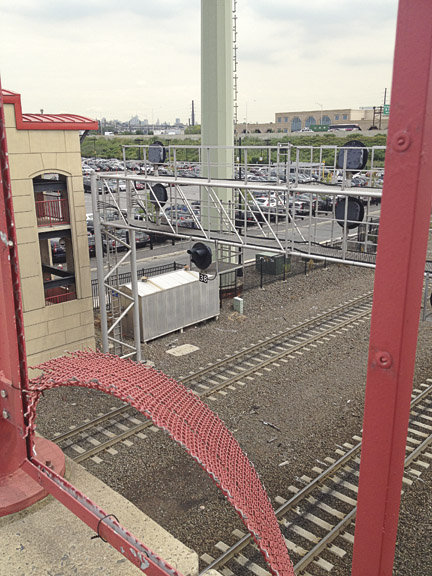It’s the bridge that’s nobody’s responsibility.
Not NJ Transit, which built it in 2003. Not Hudson County, even though a county thoroughfare crosses the bridge. Not the town of Secaucus, whose officials haven’t been able to figure out for years who is responsible for the bridge. And the New Jersey Meadowlands Commission? “Not us.”
But one thing is for certain. The residents of the nearby Xchange community, who have to use the bridge or its narrow sidewalk to go virtually anywhere, say the bridge is in disrepair, it’s dangerous, and unless someone starts fixing what’s wrong with it, somebody’s going to get hurt or killed.
“This is a life and death thing.” – Robert Glover Jr.
____________
Despite its increased use, the Red Bridge has been neglected, according to residents.
Dangerous gaps
At all hours, but especially while commuting, people walking across the elevated bridge’s sidewalk on one side of the road often have to squeeze sideways to pass each other, or step off the sidewalk into traffic.
The bridge has a safety wall on either side comprised of red metal screens that are mounted on a knee-high concrete parapet. According to Xchange resident Robert Glover Jr. the screen panels are 8 feet tall and 3 feet wide.
Several of the screen panels are missing. Xchange residents say the sidewalk has only been shoveled twice since 2008. Many residents, like Glover, walk across the bridge twice a day.
“If someone slipped in the snow or were tipsy, they would fall over the bridge and die,” said Glover. “These are big gaping holes and it is 40 feet down.”
The municipality recently allowed for residential parking by the Xchange development, which means even more people are parking in the area and walking across the bridge. People have been moving to the area this year with the opening of the third building at the Xchange this past spring. The development plans to add a fourth building with several hundred units in the future.
Last week, on a walk across the bridge, the Reporter noticed a number of screens missing and a few more leaning open that appeared as if they were about to fall off. New Jersey Transit tracks run below the bridge.
“This is a life and death thing,” said Glover. “Anyone who thinks they can lean against it can fall over into the train tracks.”
More traffic
At the time the bridge was first opened to vehicular traffic, the state was working to expand the NJ Transit line and transform the “Secaucus Transfer Station” into the Lautenberg Rail Station, which became fully operational in December 2003. Xchange opened its first building during the spring of 2008. Earlier this summer the Field Station: Dinosaur Park opened, which has drawn thousands of cars across the bridge.
“Traffic is getting worse and worse with the Dinosaur Park,” said Glover.
Glover also said that in the winter, when the sidewalk is covered in snow, people have to walk in the street alongside cars and tractor trailers. He said that since he moved to Xchange in 2008, the sidewalk has only been shoveled twice, and that once it was done at the behest of the Xchange developer’s old property manager. The sidewalk is 4 feet 9 inches wide.
“It really needs to be fixed fast,” he said.
Red Bridge, or hot potato?
Glover said that he complained to former Mayor Dennis Elwell years ago, who told him that no one would admit to owning the bridge. Glover also spoke to customer service representatives at New Jersey Transit and the Xchange management company without any success.
Last week, the municipality confirmed that the bridge is not their responsibility and pointed to the county. The county engineer and the head of the roads division said that the bridge maintenance and upkeep is the responsibility of New Jersey Transit.
“The red bridge – that belongs to New Jersey Transit,” said County Engineer Demetrios Arencibia. He oversees the county roads, bridges, and traffic signals. “We are not responsible for maintenance,” he said.
However, NJ Transit said that although they built the bridge, their agency is not responsible for taking care of it either.
“We are not in receipt of any agreement that New Jersey Transit has maintenance responsibility of the bridge,” said John Durso Jr., a NJ Transit spokesperson. He said the bridge was an element of the construction of the Secaucus Transfer Station and that the sidewalk size of 4 feet 9 inches wide was requested by the New Jersey Meadowlands Commission and the county because of the tractor trailer traffic. He said the sidewalk cannot be widened because doing so would hamper the ability of “the entity” – whoever that might be – to expand the bridge to two to three lanes.
“The track underneath – it is New Jersey transit,” said Melissa Nichols from the NJMC. “It is not ours…the bridge is not us.”
“NJ Transit maintains that there is confusion over whose responsibility it is to maintain the screens,” said James Kennelly, county spokesperson. Kennelly said draft agreements from 2003 create confusion because one attributes jurisdiction to NJ Transit, and the other gives responsibility over to the county. No final agreement has been located.
Shoveling anyone?
As far as shoveling the road, the county said they were responsible, but the level of commitment was not clear.
“If we have shoveled it in the past, it was more of a courtesy,” said Wally Wolfe, county roads and bridges division chief. “Perhaps we have to redefine our obligation.”
He said that when the county plows New County Road, they include the bridge.
Wolfe is responsible for the bridges at Clay Street in Newark and Bridge Street that cross the Passaic River.
“Certainly there should be a barrier,” said Wolfe in regard to bridge safety. “Some form of protection between the water or road.”
Adriana Rambay Fernández may be reached at afernandez@hudsonreporter.com.
